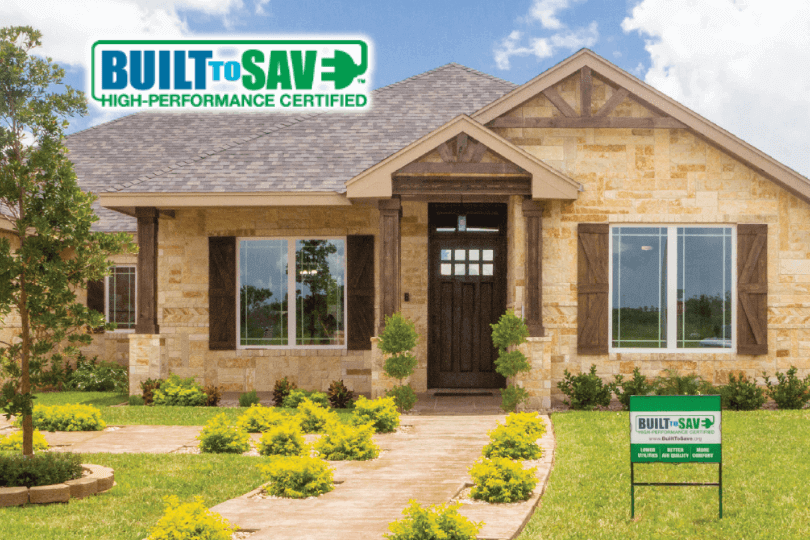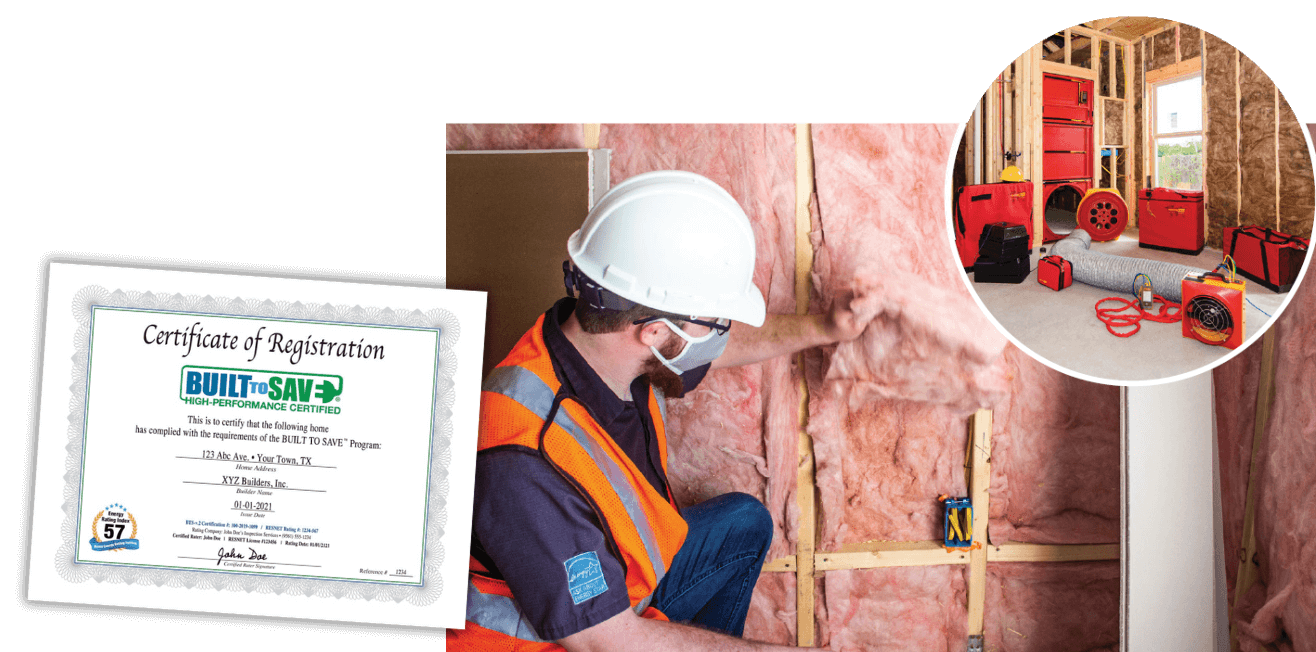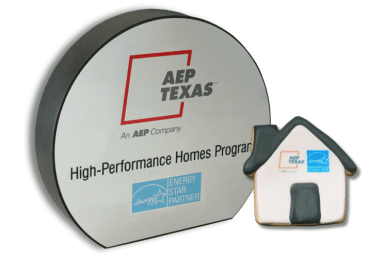Defining a BUILT TO SAVE® Verified High-Performance Home
Curious about what exactly a BUILT TO SAVE® verified home is? Allow us to shed some light on this efficient designation.
A BUILT TO SAVE® verified home is a newly constructed residence subjected to rigorous inspections and testing conducted by a third-party RESNET home energy Rater during both the construction process and upon completion. This scrutiny ensures that (1) the stringent performance requirements of the BUILT TO SAVE® program have been met and (2) qualifies the home as a high-performance
home. Such a home promises not only cost savings on utility bills compared to a standard code-compliant dwelling but also provides enhanced comfort, superior construction quality, and improved indoor air quality.
Identifying a BUILT TO SAVE® Verified Home
To ensure that the home you’re considering for purchase is indeed a BUILT TO SAVE® verified home, there are a couple of avenues you can explore. First, you can ask the builder if he/she requested certification from BUILT TO SAVE®. Certificates are provided to the builder for the homebuyers. Alternatively, you can visit www. BuiltToSave.org and utilize the “Explore – Database of Certified Homes” feature to search for the home’s address. If the address does not appear, you can reach out to info@BuiltToSave.org for further clarification.
Timing Matters for Verification
An important aspect to note is that a home can only attain BUILT TO SAVE® verification if the walls have not been covered, thus permitting a pre-drywall inspection. Ideally, the verification process should be initiated at the planning stage, even before construction commences. A meticulous review of the floorplans, elevations, and Manual J during the planning phase is critical to confirm that the home aligns with program requirements upon completion. This preliminary work and subsequent inspections and testing are done by an independent home energy Rater hired by the builder.
When Is the BUILT TO SAVE® Certificate Issued?
The BUILT TO SAVE® certificate is issued after the BUILT TO SAVE® program receives the Rater’s completed checklists and inspection/testing photos and results verified by the Rater.
BUILT TO SAVE® Verification Fees for Builders
For builders looking to secure BUILT TO SAVE® verification, there’s a nominal cost of $205 per home. The fee includes the BUILT TO SAVE® certificate for the homebuyer and a decal with whole-house systems information for the utility box panel—as mandated by local codes but few builders provide. The fee for verification is easily offset by rebates ranging from $200 to $700 or more that are offered by Magic Valley Electric Coop and AEP Texas companies based on meeting certain requirements. The Raters’ fee for the pre-drywall inspection and the final testing typically amounts to around $450, but these Rater fees should already be part of a builder’s budget if they are complying with the State’s energy code law. Builders must also be BUILT TO SAVE® members, which entails a one-time annual fee of $175. This annual fee is a bargain when compared to the amount of promotion they receive at no fee from BUILT TO SAVE® and the New Homes Guide magazine.
Qualifying for BUILT TO SAVE® Verification
To be eligible for BUILT TO SAVE® verification, a home must fulfill certain criteria listed on the Rater’s checklists. This includes features such as a well-sealed building envelope, energy-efficient windows, correctly installed insulation, appropriately sized heating, cooling, and ventilation (HVAC) systems, and a Home Energy Rating System Score of 63 or lower. Or the home can qualify with energy efficiency that is at least 5-10% superior to minimum code requirements. The builder must be a registered member of the BUILT TO SAVE® program and they must have requested its verification in BUILT TO SAVE®, both of which can be done online at www.BuiltToSave.org.
Understanding the Home Energy Rating System Score
The Energy Rating System Score (HERS) serves as the nationally recognized metric for gauging a home’s energy efficiency performance. A lower HERS score indicates greater energy efficiency. The HERS score is calculated through a certified RESNET Energy Rater’s assessment using specialized software and equipment after the home is completed. The Rater collaborates with the builder before and during construction to identify areas for improvement to ensure the home attains the lowest HERS score possible that aligns with BUILT TO SAVE® requirements.
Comprehensive Testing and Inspections
The RESNET Energy Rater conducts a series of inspections to ensure compliance. These inspections include an examination after insulation installation—but before drywall—to verify proper installation and identify potential areas of air leakage between the attic and interior spaces. Additionally, upon home completion, the Rater conducts a blower door test to measure air tightness and a duct test to assess duct system leakiness. The results of these tests, combined with data from software analysis, culminate in projecting the home’s energy efficiency performance that would certify the home’s adherence to BUILT TO SAVE® standards.
The Certainty of Energy Efficiency
In a world where all builders proclaim their homes are energy efficient, it makes sense to have an independent third-party verify those claims. The only way to be certain that a home is an energy-efficient, high-performance home is to have a certificate that verifies that fact. A BUILT TO SAVE® verified home is guaranteed to provide more savings on utilities than a similar home built to minimum code and will provide more comfort and better indoor air. Best of all, a BUILT TO SAVE® certificate will be of great value should you decide to sell your home.
Visit www.BuiltToSave.org to find out more about why you should not settle for a minimum code-built home when you can enjoy the savings and comfort of a high-performance home. You can also find builders enrolled in the BUILT TO SAVE® program offering high-performance homes.
© RGV New Homes Guide, 2023. Unauthorized use and/or duplication of this material without express and written permission from this site’s author and/or owner is strictly prohibited. Excerpts and links may be used, provided that full and clear credit is given to RGV New Homes Guide with appropriate and specific direction to the original content.







